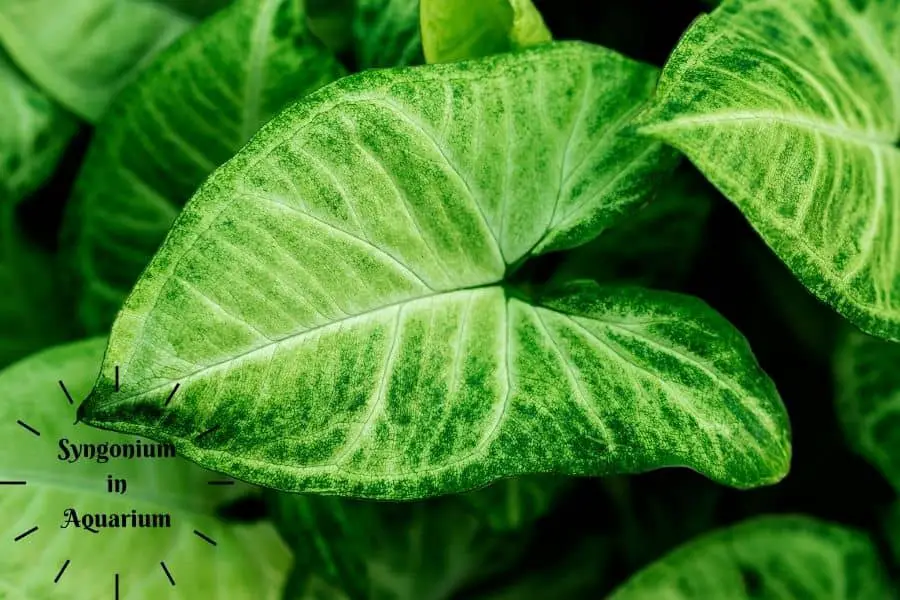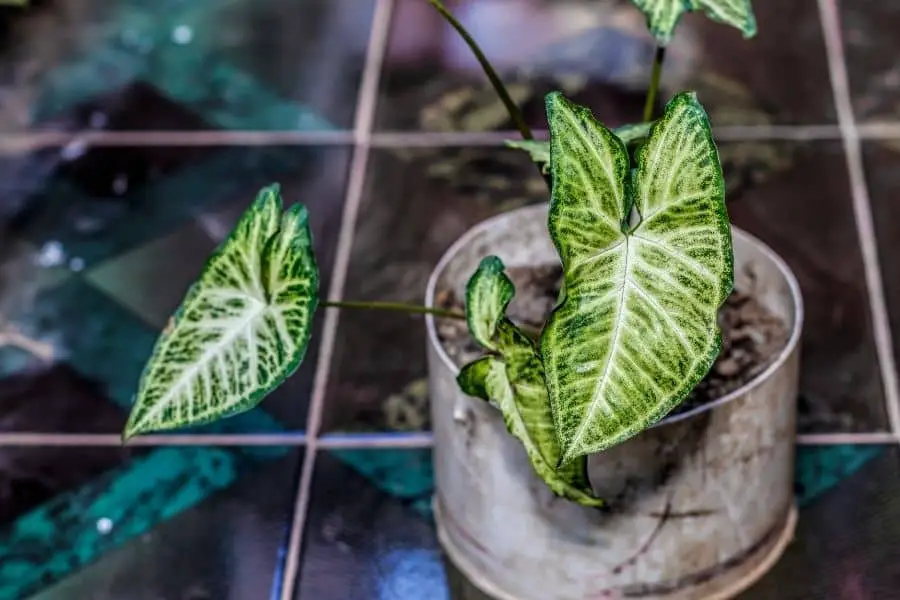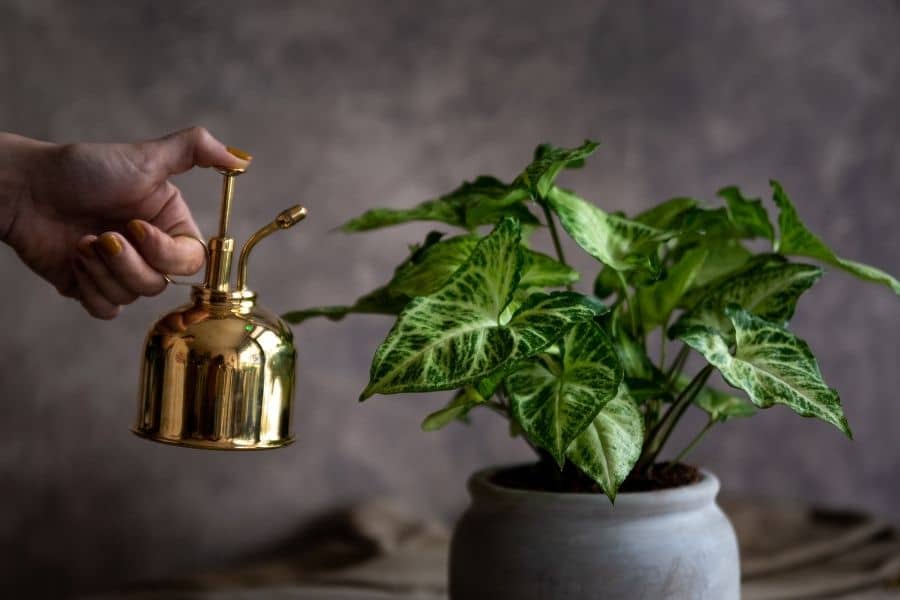Syngonium podophyllum, mostly known as the Arrowhead plant, has several other names; arrowhead vine, American evergreen, five fingers, and nephthytis. Arrowhead is popular among gardeners as a houseplant and usually grows as a hanging plant. The plant has green and white variegated leaves in a spade-like shape that gives a fresh look to any corner.

Can I Grow Syngonium in Aquarium?
Jump To
Yes. Although many Aquarists advise against it, you can grow Syngonium in Aquarium. However, you should be careful if you have any plant-eating fish in your Aquarium.
All parts of Syngonium contain calcium oxalate crystals that can cause gastrointestinal problems and allergies to humans and house pets. Although the toxicity for fish hasn’t been found, it’s better not to let the fish eat the plant.
Syngonium can’t live underwater. So it will survive in water for some time if you keep only the roots in water. Also, you should keep its foliage out of the water. Or else the foliage will rot.

How to Grow Syngonium in Aquarium?
Keeping only the roots of the plant submerged, you need to take the necessary precautions to keep the fish out of the plant. To do this, you can use a HOB filter in your tank. It is an aquarium filtration system that filters water by sucking the water from the bottom and throwing filtered water on the Aquarium’s top.
The current it makes on the water’s surface usually keeps the fish at bay to not bother eating the Syngonium plant. When the plant is well grown, it no longer can hold all of its leaves out of the water. So some leaves go down the water and rot. You have to remove these rotted leaves from the Aquarium.

Benefits of Syngonium Plant in Aquarium
Although keeping an arrowhead plant is not safe for your (plant-eating) fish, there are some benefits of Syngonium in Aquarium.
Removes Nitrates
Like the Pothos plant, the Syngonium plant is also capable of removing Nitrates from the water. It absorbs Nitrates and other Nutritions as fertilizers for the plant. Also, the fish waste and other leftover foods produce Nitrates in your Aquarium, and they are toxic for your fish. You can regularly change the water to remove these Nitrates.
Still, if you keep a houseplant like Syngonium in your Aquarium, it will remove Nitrates more efficiently, which leaves less hassle changing your Aquarium’s water.
Removes Odors
Syngonium is capable of removing odors from your Aquarium. When you grow the Arrowhead plant in your Aquarium, you will notice that the fishy or earthy smell has disappeared from the environment. This fresh small is because it has air purifying ability.
Combat Algae
The leading causes of algae growth in an aquarium are light and Nitrates. When you grow Syngonium in your Aquarium, as it grows, it takes almost all the Nitrates in your Aquarium, and its foliage reduces the light of your Aquarium. Thus, Algae’s growth (Especially hair algae and blue-green algae) diminishes and eventually disappears because of these reduced Nitrate levels and light.
Enhance the Look
Keeping live plants can make your Aquarium look natural. Adding Arrowhead plant helps remove nitrate levels and remove your Aquarium’s odors and gives an incredible look into your Aquarium because of its beautiful foliages.
Purifies the Air
Syngonium is known as a good air purifying plant. You will have nice clean air around your Aquarium if you keep an Arrowhead plant in your Aquarium.

Syngonium Submerged in Aquarium
You can not grow Syngonium fully submerged in an Aquarium. If you keep an arrowhead plant fully immersed, all of its foliage will rot, and the plant will die.
Syngonium Plant Care in Aquarium
For the Syngonium plant to thrive in the water, you have to provide needed conditions in your Aquarium.
Light Condition
Arrowhead plants can tolerate low light conditions but will flourish in bright indirect light conditions. You have to avoid direct sunlight as it will scorch the leaves.
Temperature
Arrowhead plant needs an average temperature of 65°F-75°F to thrive but can tolerate a more comprehensive range if necessary. If you keep a temperature comfortable to you around your Aquarium, that’s enough for the Arrowhead plant.
Fertilizer
Usually, the Nitrates and other nutrients of your Aquarium are used as fertilizer for the Arrowhead plant. So, there will be no need in adding any fertilizers to your plant.
Water
For the Arrowhead plant to thrive, you should keep the plant out of the water keeping only the roots submerged. Otherwise, the plant will rot and die.
Toxicity of Syngonium Plant
The Arrowhead plant is toxic to humans, dogs and cats as it contains calcium oxalate crystals which cause stomach and mouth irritation. So, always keep this plant out of children and house pets.

If swollen and shows any stomach symptoms or allergic reactions, seek immediate medical attention. Additionally, you should wear gloves when working with the Arrowhead plant as it’s sap can be irritating to sensitive individuals.
Credit to: H2O Plants
Read more: 10 Emergent Aquarium Plants for fish tank
Related: Pothos In Aquarium |Is It Possible 12 Interesting Facts
